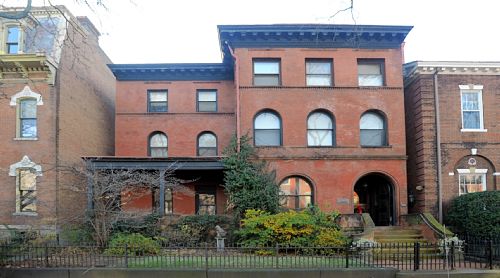
Allegheny West’s Annual Holiday House Tour Shows Off Style, Taste and City History
On Thanksgiving eve, when I called Alex Watson about previewing his house for next weekend’s Allegheny West Victorian Christmas House Tour, I assumed it would be too early to see it in holiday garb.
“Oh, that won’t be a problem,” he said. “My Christmas tree has been up for three years.”
When your house has been on the tour for 28 of the event’s 29 years, leaving the artificial tree up and decorated in a corner of the library seems the expedient thing to do.
Next to it, on the mantel, stands the illuminated Dickens Christmas village Mr. Watson made decades ago of fiberboard, crowned by London’s St. Paul Cathedral and complete with Scrooge & Marley’s counting house. It’s now a year-round feature, too.
And next to that, on the wainscot ledge, stand a dozen smaller buildings closer to home, representing Allegheny West houses that have appeared on neighborhood tours. He and his neighbors made those, too, for sale to tour-goers in years past.
Anything to support his beloved Allegheny West, the North Side neighborhood in which he and his late partner, Merle Dickinson, settled in 1960, when they purchased the North Lincoln Avenue home. Then broken into 17 (now 10) apartments, it was far from the showplace it is today.
The red brick house, originally a two-story built between 1864 and 1865, was enlarged to its present three-story size and Romanesque Revival appearance in the early 1890s, when a library also was added to the front of the house.
Grain merchant John W. Simpson was the original owner; Joseph Walton bought it in 1888 for daughter Ida Walton Scully and her husband, glass manufacturer James Scully. In 1917 the house was sold to James S. Childs, a shoe, rubber and leather wholesaler whose wife Alice was Ida Scully’s sister.
In 1923 the house changed hands again; the new owners were Samuel and Margaret Crow, who lived there and rented rooms to boarders. The house stayed in the Crow family until 1960.
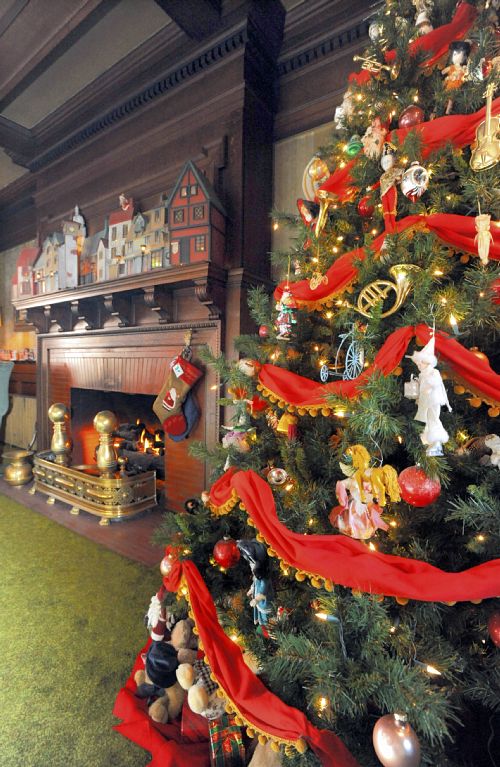
The library in Alex Watson's North Lincoln St. home is decorated for the holidays. Bob Donaldson / Post-Gazette
The house’s architect is unknown; none surfaced during architectural historian Carol Peterson’s extensive house history research. Mr. Watson thinks it may have been Longfellow, Alden and Harlow, who in 1889 completed a house across the street commissioned by B. F. Jones for his daughter Elizabeth and her husband, Joseph O. Horne, son of the department store founder. It’s a good bet, considering the richly carved and paneled oak interior finishes, the melding of medieval and classical influences and a first-floor layout similar to the Horne house. The firm designed 13 buildings within a radius of several blocks and Frank Alden had lived just around the corner.
Restoring the home’s original features became a decades-long passion for Mr. Watson and Mr. Dickinson, who did much of the work themselves. And there was much work to do. While most of the interior woodwork remained, the first floor’s front parlor, library and dining room had been its own apartment with kitchen and bath.
One bathroom occupied a corner of the entrance hall; during its removal, the owners discovered a long-lost corner of the hall’s original mantel. From that remnant, they re-created the mantel and over-mantel and warmed up the room with a gas fireplace.
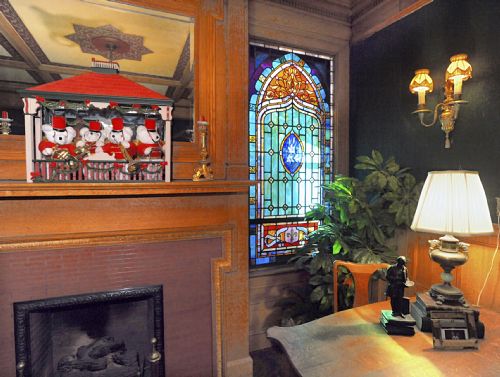
The hallway in Alex Watson's North Lincoln St. home is decorated for the holidays. Bob Donaldson / Post-Gazette
Mr. Watson has his regrets, including removal of a mantel and overmantel in the front parlor to gain wall space. They recycled it as a bar and back bar in the former kitchen, now a game room outfitted as a bordello dedicated to 1920s neighborhood madam Nettie Gordon. Eventually, in atonement, they purchased a white marble Italianate mantel from a Sewickley house sale for the front parlor.
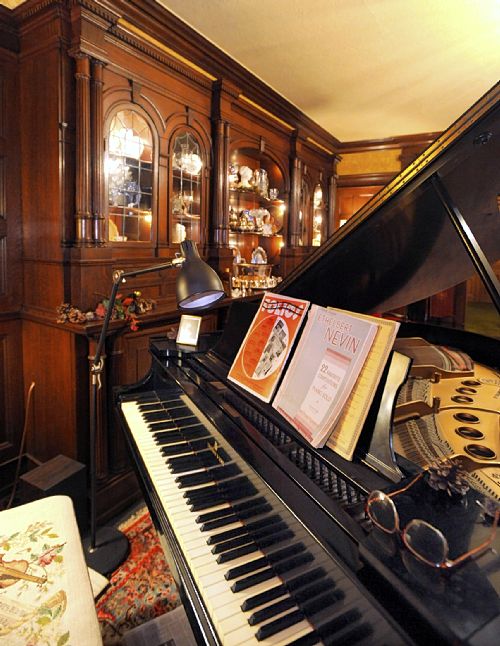
The music room in Alex Watson's North Lincoln St. home. Originally the home's dining room, the breakfront still dominates the room. The home will be on the Allegheny West Christmas House Tour. Bob Donaldson / Post-Gazette
In the former dining room, now the music room, Mr. Watson (on the piano) and friend Mark Schumacher (on the organ) plan to greet tour-goers, as they have in years past, with songs of the season. Seeing the faces of visitors as they enter the room, Mr. Watson said, “makes the whole thing worthwhile.”
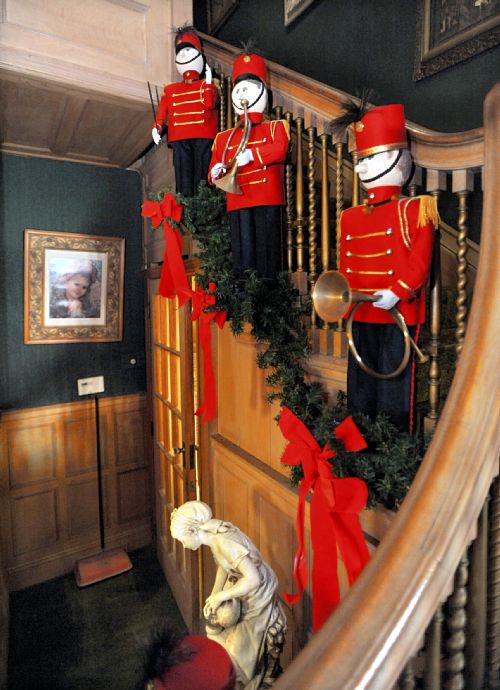
The hallway in Alex Watson's North Lincoln St. home is decorated for the holidays. Bob Donaldson / Post-Gazette
Trained in nursery and landscape management at Michigan State, Mr. Watson managed the garden shop at Sears for 27 years before it became part of Allegheny Center. His courtyard garden, glimpsed through the oak-paneled music room windows, has been featured on neighborhood garden tours; this time tour-goers will pass through it as they leave.
The six houses on the tour, spread over three blocks, include Gretchen Duthoy’s red brick, Second Empire-style Beech Avenue home, a newbie to the event.
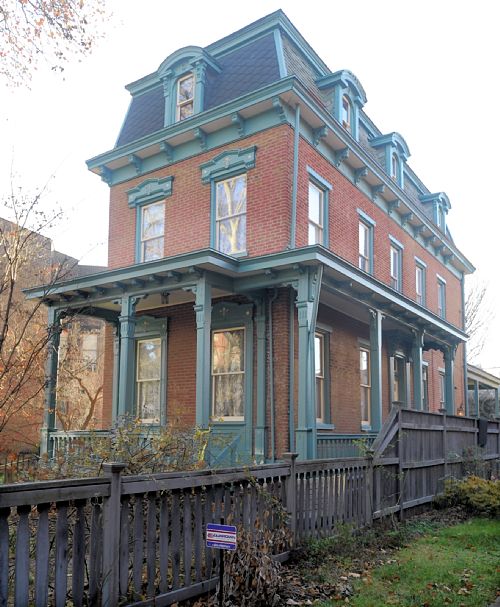
This home at 849 Beech Ave. will be on the Allegheny West Christmas House Tour. Bob Donaldson / Post-Gazette
“My house was turning 150 this year,” said Ms. Duthoy, who wanted to do something to mark the occasion. She commissioned a house history from Ms. Peterson, who discovered the house in fact was 140 years old, having been built in 1870 for railroad conductor Theodore Gray and his wife Annie. The longest ownership — 1887 to 1922 — came with four generations of the family of Christian Stoner, partner in a Strip District lumber mill.
When Ms. Duthoy, an Alcoa employee who grew up in suburban Maryland, bought the house in 2003, it had been restored by its previous owners, for whom she’d worked as a baby sitter in college.
“That’s how I came to know the house and the neighborhood and that’s how I came to live there” a few years later when they had outgrown it, she said.
Her work on the house has been cosmetic, including a kitchen update. For the tour she’ll hang family ornaments on her live tree and decorate extensively with fresh greens.
The tour, she said, is “a great showcase for the neighborhood, and I’d like to do my part.”
Information: Guided walking tours cost $25 per person and leave from Calvary United Methodist Church, Allegheny and Beech avenues, at 12-minute intervals from 5 to 8 p.m. Friday, and 10 a.m. to 8 p.m. next Saturday, with a maximum of 25 guests per tour. Tour guides will talk about 19th-century holiday traditions and the history of the neighborhood and the homes on the tour.
At the end of the event, which lasts about three hours, tour-goers can visit John DeSantis’ miniature railroad village and toy train collection at Holmes Hall, 719 Brighton Road, for an additional $10, as well as the Holiday Shoppe at Jones Hall, with antiques, gifts and handcrafted items. Mr. DeSantis’ train collection, open to the public only during the Christmas tour, also can be visited separately; hours are 7:30 to 10 p.m. Friday and 12:30 to 10 p.m. Saturday.
Special tours include a wine tour at 6 p.m. Friday, with wine tasting and hors d’oeuvres at a private residence, followed by the house tour ($75 per person). On Saturday, brunch tours will be offered at 10 and 10:30 a.m. and high-tea tours at 3 and 3:30 p.m. ($50 per person), followed by the house tour. With help from The Center for Hearing and Deaf Services, a signed tour will be offered at 3:36 p.m. Saturday ($25 per person).
Tours are rain or shine, snow, sleet or hail. As the Allegheny West Civic Council’s website puts it, “This is Pittsburgh and bad weather is part of the charm.” Reservations are required for all tours and tickets are nonrefundable. Visit the website (alleghenywest.org) or call 412-323-8884.

